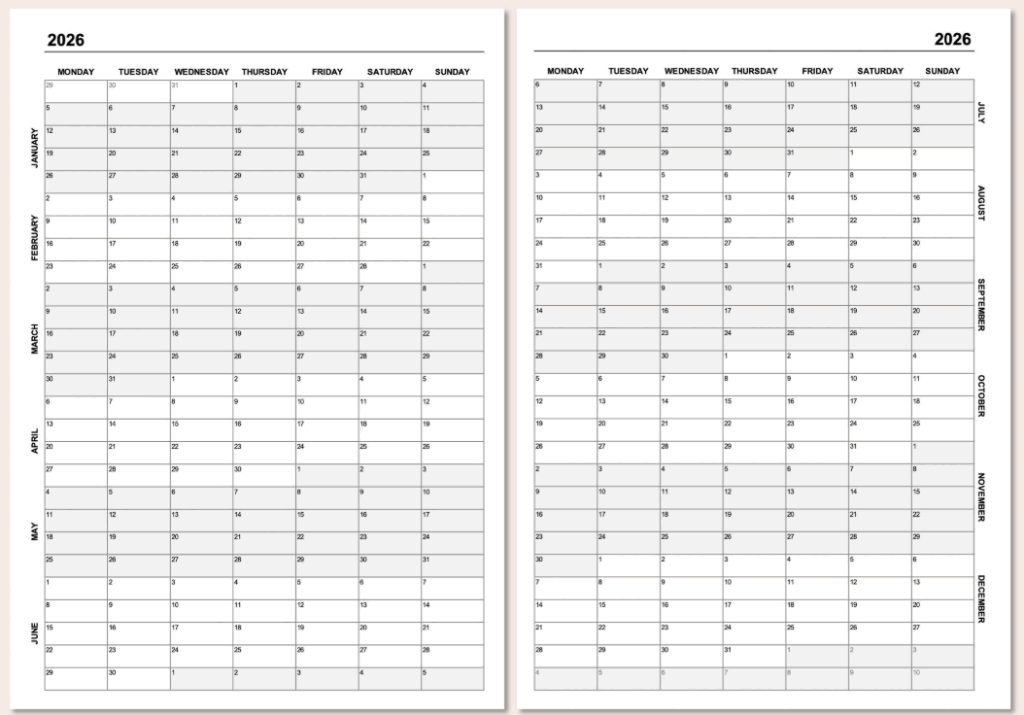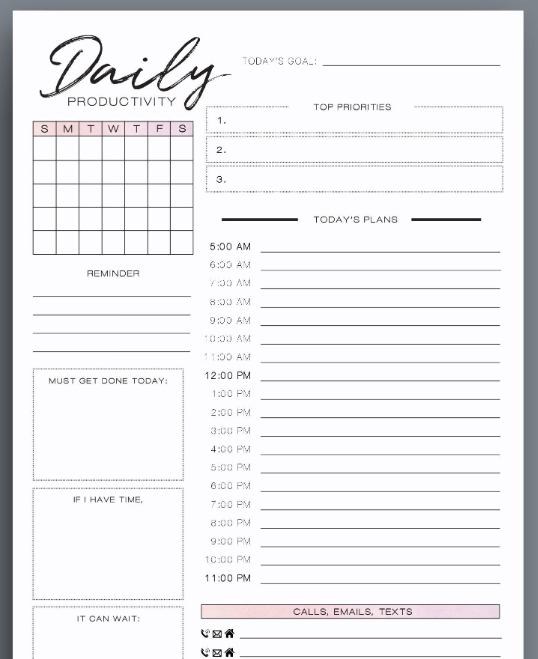Effective planning and productivity systems form the foundation for achieving goals, maintaining organization, and maximizing personal and professional success. The Planner & Productivity Ideas for 2026 – Free Templates & Tips provides comprehensive strategies, customizable templates, and practical implementation guidance for building sustainable planning systems. By integrating proven productivity methodologies, thoughtful template design, and consistent habit formation, individuals and teams establish powerful frameworks supporting goal achievement throughout the year.

Why Comprehensive Planning Matters in 2026
- Goal clarity: Structured planning aligns daily actions with long-term objectives
- Time optimization: Strategic systems prevent wasted time on low-value activities
- Stress reduction: Organized planning creates psychological security and confidence
- Progress tracking: Visual systems maintain motivation through measurable advancement
- Balance maintenance: Integrated planning supports work, personal, and wellness priorities
- Adaptability: Flexible systems enable adjustment to changing circumstances
Core Components of Effective Planning Systems
1. Annual Goal Setting
Begin 2026 by establishing 3-5 significant goals across major life domains. Use SMART criteria (Specific, Measurable, Achievable, Relevant, Time-bound) to ensure clarity and attainability.
Goal Categories
- Career/Professional: Promotion, business launch, skill development
- Financial: Debt reduction, savings targets, investment growth
- Health/Wellness: Fitness goals, nutrition plans, mental health practices
- Relationships: Family time, social connections, partnership goals
- Personal Development: Learning objectives, hobbies, spiritual growth
Annual Goal Template
| Category | Goal | Measurement | Deadline | Status |
|---|---|---|---|---|
| Career | Complete project management certification | Pass PMP exam | June 30, 2026 | In Progress |
| Financial | Save $12,000 for emergency fund | $1,000/month savings | December 31, 2026 | Planned |
| Health | Run half-marathon | Complete 13.1 miles under 2.5 hours | October 15, 2026 | Planned |
2. Quarterly Milestone Planning
Break annual goals into quarterly (12-week) milestones creating achievable progress markers. Quarterly planning sessions identify specific actions required for milestone attainment.
Quarterly Planning Process
- Review annual goals and assess previous quarter progress
- Identify 1-2 key milestones per goal for current quarter
- Break milestones into monthly deliverables ensuring steady progress
- Create quarterly action plan with specific tasks and due dates
- Schedule quarterly review (end of March, June, September, December)
3. Monthly Goal Setting
Each month begins with monthly planning session connecting quarterly milestones to specific weekly actions. Monthly goals represent concrete progress toward quarterly milestones.
Monthly Planning Template
| Month | Quarterly Milestone | Monthly Goal | Key Actions | Success Measurement |
|---|---|---|---|---|
| January 2026 | Start PMP certification preparation | Complete PMP exam application and study materials | – Apply for exam – Order study materials – Complete first study week | Application submitted; materials received |
| February 2026 | Begin half-marathon training | Establish running routine (3x/week) | – Complete 3-mile runs – Begin strength training – Purchase running gear | Complete 12 runs; establish routine |
4. Weekly Planning Sessions
Dedicate 30-60 minutes weekly (typically Sunday evening or Monday morning) to plan the upcoming week. Weekly planning ensures daily tasks align with monthly goals and quarterly milestones.
Weekly Planning Process
- Review last week’s progress against planned goals
- Identify monthly goal focus for current week
- Create 3-5 Most Important Tasks (MITs) for the week
- Block time in calendar for MITs and key activities
- Schedule buffer time for flexibility and unexpected needs
- Plan personal and family commitments alongside work
5. Daily Task Management
Daily planning involves selecting 3-5 MITs from weekly priorities and scheduling them during peak productivity periods. Daily task management focuses on execution and completion.
Daily Task Template
| Date | Weekly Priority | MIT 1 | MIT 2 | MIT 3 | Additional Tasks | Reflection |
|---|---|---|---|---|---|---|
| Monday, Jan 6 | PMP Study | Complete PMBOK Chapter 1 | Apply for PMP exam | 3-mile run | Email responses, admin tasks | Chapters read: 1/12 |

Free Printable Planner Templates for 2026
1. Annual Goal Planning Template
Purpose: Establish comprehensive yearly goals and progress tracking
- Annual goal overview sheet
- Quarterly milestone planning sections
- Monthly check-in spaces
- Progress tracking charts
- Year-end reflection prompts
2. Quarterly Planning Template
Purpose: Break annual goals into actionable quarterly milestones
- Quarter overview and milestones
- Monthly action plan sections
- Key dates and deadlines
- Resource allocation planning
- Quarterly review and assessment
3. Monthly Goal Tracker
Purpose: Connect quarterly milestones to monthly objectives
- Monthly goal statements
- Weekly breakdown sections
- Progress tracking charts
- Resource and time allocation
- Monthly review questions
4. Weekly Planner Template
Purpose: Detailed weekly planning and task management
- Weekly goals and MITs
- Daily schedule template
- Time blocking sections
- Priority ranking
- Weekly review and reflection
5. Daily Planner Template
Purpose: Execute daily priorities with focused attention
- Daily MITs (3-5 items)
- Time blocking schedule
- Priority ranking system
- Habit tracking checkboxes
- End-of-day reflection

6. Habit Tracker Template
Purpose: Build and maintain positive daily habits
- Monthly habit tracking grid
- Habit success percentage calculation
- Streak counter
- Habit notes and adjustments
- Accountability partner tracking
7. Project Planning Template
Purpose: Manage complex projects with clear milestones
- Project overview and timeline
- Milestone planning
- Task breakdown and delegation
- Resource allocation
- Risk assessment and contingency
Productivity Systems and Methodologies
Getting Things Done (GTD) Integration
Core Concepts:
- Capture everything: Record all tasks, ideas, commitments immediately
- Clarify next actions: Decide what action (if any) required for each item
- Organize systematically: Use contexts, priorities, projects to categorize items
- Reflect regularly: Weekly review maintains system currency
- Engage confidently: Trust system enables focused execution
Time Blocking Implementation
Daily Structure:
- Deep work blocks: 90-120 minutes for focused, high-value work
- Meeting windows: 2-hour blocks for all scheduled meetings
- Administrative time: 60-90 minutes for email and routine tasks
- Buffer periods: 15-30 minutes between blocks for transitions
- Personal time: Protected blocks for exercise, family, wellness
Eisenhower Matrix for Priority Management
| Urgent | Not Urgent | |
|---|---|---|
| Important | Do First (Quarter 1) | Schedule (Quarter 2) |
| Not Important | Delegate (Quarter 3) | Eliminate (Quarter 4) |
Pomodoro Technique Integration
- 25-minute work intervals with 5-minute breaks
- 4 Pomodoros followed by 15-30 minute longer break
- Distraction-free focus during each Pomodoro
- Progress tracking by completed Pomodoros
- Daily Pomodoro planning (typically 8-12 Pomodoros)
Digital Tools for 2026 Planning
Calendar and Scheduling Apps
- Google Calendar: Free, cross-platform, excellent collaboration
- Microsoft Outlook: Enterprise-grade, strong integration
- Apple Calendar: Seamless iOS/macOS integration
- Fantastical: Natural language input, beautiful interface
- Reclaim.ai: AI-powered scheduling, focus time protection
Task Management and Planning Apps
- Todoist: Excellent for task management and habit building
- Notion: Customizable all-in-one workspace
- Asana: Project management with calendar integration
- Trello: Visual kanban boards for task organization
- ClickUp: Comprehensive project management platform
Habit Tracking and Wellness Apps
- Habitica: Gamified habit building and task management
- Streaks: iOS habit tracker with visual progress
- Fabulous: Science-based habit formation
- Loop Habit Tracker: Android open-source habit tracking
- Productive: Comprehensive habit and routine tracking
Hybrid Planning Systems
Digital + Paper Integration
- Digital calendar for appointments, meetings, and collaborative scheduling
- Paper planner for daily task management and reflection
- Weekly sync between digital and paper systems
- Morning routine: Transfer digital events to paper planner
- Evening reflection: Capture paper insights in digital system
Multiple Device Synchronization
- Phone, tablet, computer, and smartwatch integration
- Cloud synchronization ensuring real-time updates
- Offline access for critical planning components
- Voice activation through digital assistants
- Automatic backup and version control
Planning System Customization
Personal Planning System Design
- Identify planning style (digital, paper, hybrid, visual, list-based)
- Determine time commitment (quick planning vs. detailed systems)
- Select appropriate tools matching lifestyle and preferences
- Create core templates for consistent use
- Establish review cadence (daily, weekly, monthly, quarterly)
- Build supporting habits for system maintenance
Family/Group Planning
- Shared digital calendar for family appointments and events
- Color-coded family members in shared calendars
- Weekly family planning meeting to coordinate schedules
- Central communication hub for family logistics
- Individual planning systems that sync with family calendar
Team/Professional Planning
- Team shared calendar with availability and meeting scheduling
- Project management integration with individual task planning
- One-on-one meeting cadence built into planning system
- Team-wide goal alignment with individual planning
- Cross-training documentation and knowledge transfer
Common Planning Mistakes and Solutions
Mistake 1: Overcomplicating the System
Solution: Start simple with basic goal setting and daily task list. Add complexity gradually as system becomes habit.
Mistake 2: Lack of Review and Adjustment
Solution: Schedule weekly review (Sunday evening or Monday morning) to assess progress and adjust priorities. Monthly and quarterly reviews for long-term alignment.
Mistake 3: Ignoring Energy Patterns
Solution: Identify personal productivity cycles (morning person, night owl, afternoon peak) and schedule accordingly. Use time blocking to protect peak energy periods.
Mistake 4: Setting Unrealistic Goals
Solution: Use SMART criteria and break large goals into smaller, achievable milestones. Focus on progress, not perfection.
Mistake 5: Failing to Communicate System
Solution: Share planning system with family, team, or accountability partners. Clear communication prevents scheduling conflicts and maintains alignment.
2026 Planning Calendar Integration
Holiday and Seasonal Planning
- Mark holidays in annual calendar early in planning process
- Plan holiday preparation time (shopping, decorating, travel)
- Schedule vacation time around school and work holidays
- Adjust productivity expectations during holiday periods
- Plan post-holiday recovery and routine re-establishment
Quarterly Planning Dates
- Q1 Review (January 15-20, 2026): Assess holiday planning success; set Q2 goals
- Q2 Review (April 15-20, 2026): Spring break reflection; summer planning
- Q3 Review (July 15-20, 2026): Summer review; back-to-school preparation
- Q4 Review (October 15-20, 2026): Holiday planning; year-end goal assessment
Conclusion
Comprehensive planning systems transform aspirations into achievements by creating structured pathways for goal execution and daily productivity. By establishing clear annual goals, breaking them into quarterly milestones, monthly objectives, weekly plans, and daily tasks, individuals create sustainable systems driving meaningful progress. Free printable templates, digital tools, and proven methodologies like GTD, time blocking, and the Eisenhower matrix provide flexible frameworks supporting diverse planning styles and needs. Whether using digital calendars, paper planners, or hybrid systems, successful planning requires consistent review, realistic goal setting, and adaptation to changing circumstances. Implement these 2026 planning strategies and templates today to establish powerful systems supporting personal growth, professional success, and balanced living throughout the year.


